|
 Gymnopilus pyrrhum Gymnopilus pyrrhum
SynonymsCrepidotus pyrrhus
Pyrrhoglossum pyrrhum
Agaricus pyrrhus
BiostatusPresent in region - Indigenous. Non endemic
Images (click to enlarge)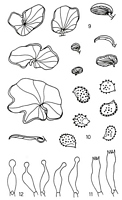
Caption: (ZT 77/68; New Caledonia):9. basidiomes. -10. spores. -11. basidia. -12. cheilocystidia. | 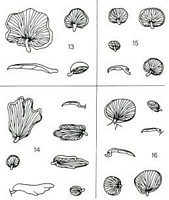
Caption: (ZT 73/281; Papua New Guinea): 13. basidiomes
(ZT 68/237; New Zealand): 14. basidiomes.
(ZT 2098; New Zealand): 15. basidiomes.
(ZT 542; New Zealand): 16. basidiomes. | 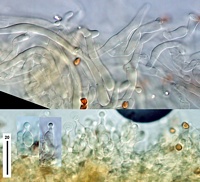
Caption: top: cap hyphae. Bottom: cheilocystidia
Owner: J.A. Cooper | 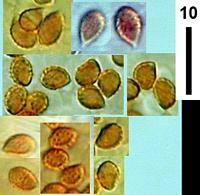
Caption: spores
Owner: J.A. Cooper | 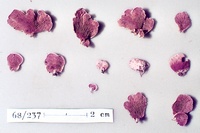
Caption: ZT68-237
Owner: E. Horak: © Creative Commons Attribution-Noncommercial 3.0 New Zealand | 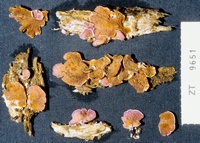
Caption: ZT9651
Owner: E. Horak: © Creative Commons Attribution-Noncommercial 3.0 New Zealand |
Article: Horak, E. (1989). New and additional data concerning Pyrrhoglossum and eccentric or laterally stipitate taxa of Gymnopilus (Agaricales). Opera Botanica 100: 115-129.
Description: (PDD 27219, ZT 68/237):
Pileus 3-25 (-35) mm. hemispherical later becoming ovoid or fan-shaped, irregularely conchiform with lobed inrolled margin, centre convex or expanded, never depressed; at first conspicuously lilac in young specimens, often with pink tinge, original colour soon fading away and cuticle turning brown, argillaceous, pale yellow-brown or cream grey in over-mature specimens; dry, densely covered by silky radially appressed fibrils, margin nonstriate, veil remnants none. Lamellae very crowded, narrow (1-2.5 mm broad), adnate to adnexed; conspicuously lilac at first slowly turning to ochre-brown or rust brown, white edge fimbriate to crenulate. Stipe -6 x -2 mm, cylindrical, eccentric to lateral, strongly curved, occasionally absent and then pileus laterally or sub dorsally attached to substrate; concolorous with pileus; dry, solid, pruinose, occasionally with white rhizoids at base, single in dense groups but never fasciculate; veil remnants none. Context membranaceous in pileus and stipe, brown lilac turning pale brown. Odour not distinctive. Taste like radish. Chemical reactions: KOH - negative.
Spore print rust brown. Spores (4-) 4.5-5 x (3-) 3.5-4 µm, ovoid to pip-shaped, supraapicular depression well developed, plage distinct, conspicuously verrucose, warts embedded in distinct perisporium, rust brown. Basidia 15-25 x 4-6 µm, 4-spored. Cheilo-cystidia 12-22 x 3-6 µm, lecythiform, capitate apex -4 µm diam., membrane hyaline, thin-walled, any encrusting or plasmatic pigment absent. Pleurocystidia none. Caulocystidia numerous, shape and size like cheilocystidia. Pileipellis a cutis composed of cylindrical hyphae (2-6 µm diam.), terminal cells not differentiated, non-gelatinised membrane strongly encrusted with yellow-brown pigment not dissolving in KOH. Clamp connections present on all septa.
Habitat: On bark and rotten wood of decaying logs and trunks of both deciduous (Fagaceae) and coniferous (Podocarpaceae) trees
Distribution: Cuba (type), Lesser Antilles (Dominica, Guadeloupe, Martinique), Trinidad, Venezuela, Brazil (Rick. 1961), USA, New Zealand, New Caledonia, New Guinea.
Notes: According to the list of known records this rather polymorphic species has been encountered from several localities both in Central America (and adjacent countries) and in Australasia. The eastern collections compare well with the specimens from the Carribean region, which as a notable difference have more robust and larger basidiomes.
The distinctive lilac colour in P. pyrrhum (Pegler 1983, pi. 17 C-D) is only observed in young and fresh material. In old specimens often no trace of lilac tints can be seen. Identifying this taxon that remarkable change of colour must be kept in mind.
P. pyrrhum keys out near P. hepatizon. The two taxa, however, are readily distinguished by several macro characters, viz. size/colour of the basidiomes and shape/point of insertion of the stipe. The microscopical features of these two, in several regions sympatric, taxa are very much alike and therefore the identification of dry material (without detailed notes taken from fresh specimens) can be difficult.
|